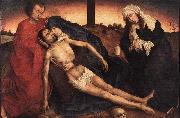China al por mayor de Marco de Oleo |
|||||||||||

|
|||||||||||
|
|
|
||||||||||||||
|
WEYDEN, Rogier van der
Netherlandish Northern Renaissance Painter, ca.1400-1464 |
||||||||||||||
|
|
||||||||||||||
|
||||||||||||||
|
|
||||||||||||||
| WEYDEN, Rogier van der
Netherlandish Northern Renaissance Painter, ca.1400-1464 1441 Wood, 32,2 x 47,2 cm Mus?es Royaux des Beaux-Arts, Brussels The latest studies attribute this Lamentation directly to Rogier van der Weyden, a pupil of the Master of Fl?malle and one of the most important and influential of the Flemish Primitives. The style and pictorial qualities of the painting match those of other Van der Weyden panels that are documented by archival material. A few authors, however, believe this Lamentation to be by his workshop, because of the various versions that exist of this composition, some of which have definitely been produced by assistants. Van der Weyden had so much work that he left the reproduction of popular compositions like the Lamentation to the other painters in his workshop. Dendrochronological research - the dating of a wooden panel based on the growth rings - places this version at around 1441, i.e. relatively early in the painter's career. Depicted is the lamentation of Christ under the cross, a scene that does not appear as such in the Bible. To the left we see John the Evangelist, barefoot and robed in a red mantle. His right hand supports the Saviour's upper body, which is resting against the Virgin's knee. With his left hand he is comforting Mary. The Mother of God supports her Son's limp head and presses her cheek against his. At Christ's feet Mary Magdalen kneels in veneration, alongside her an ointment pot, her customary attribute. The skull in the foreground refers to the location, Golgotha, literally "place of the skull". Apocryphal texts frequently interpret this as the skull of Adam, whose fall brought death on the human race, and whose original sin Christ died to expiate. The withered trees to the left and right are also taken from medieval Passion stories, certain of which tell that all trees withered when the Saviour gave up the spirit. The emotional intensity of the Lamentation witnesses to the influence of 'devotio moderna', with this type of tableau intended to move the viewer to compassion. Closer contemplation of the Passion would then lead to the imitation of Christ, or place the viewer into the right frame of mind to receive communion.Artist:WEYDEN, Rogier van der Title: Lamentation Painted in 1401-1450 , Flemish - - painting : religious |
||||||||||||||
|
Related Paintings to WEYDEN, Rogier van der :. |
||||||||||||||
|
|
||||||||||||||
|
|
||||||||||||||
|
CONTACTE EEUU |







